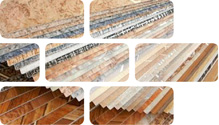
Vinyl Floor Flooring 17 02 03
Vinyl floor is produced from vinyl compositions or polyvinyl chloride (PVC) to form a pliable sheet that is often cut into tiles. It is manufactured in a range of sizes, varying thickness, pattern and finish depending on the colour and pattern required. It is a low-cost and durable product that is easily maintained. Be aware that some older tiles may contain asbestos.
Personal Protective Equipment
PPE requirements indicated are for guidance purposes only. DRIDS has identified the PPE that is mandatory on all demolition projects and ones that may be required subject to site specific Risk Assessment & Method Statement (RAMS). Hover over the icon to determine the types of PPE required for the removal of this material.
Removal, Segregation & Storage
Vinyl flooring is relatively easy to remove, but can be brittle and breaks easily. Vinyl floor tiles that are in good condition, not damaged and not fixed in place with glues will have some reclamation and reuse value - unless they are reinforced with asbestos fibres pre-1990. They should be segregated and stored flat on a suitably sized pallet, wrapped in cling film and stored to keep them dry and away from plant movements. Vinyl flooring destined for recycling should be segregated into a skip, or if destined for incineration with energy recovery stored in a segregated skip along with similar items of calorific value.
Fixtures, Fittings & Connections
Vinyl flooring is traditionally fixed in place with a glue or adhesive, although some will be laid in place without adhesive. Vinyl flooring may be integr.ated with door strips or edging strips for safety and decorative prurposes. Vinyl flooring used for stairs and stair wells will most certainly be glued in place, or fitted within a recess or fixed with edging strips.
Health & Safety
Subject to task-specific Risk Assessment & Method Statement (RAMS). Use correct protective equipment for removing fixings especially screws, door strips and edging strips. Wear gloves when handling vinyl flooring especially those coated in glues or adhesives to prevent iritation and cuts. Wear eye protection when removing screws with a crowbar, hammer or bolster chisel. The removal of asbestos containing tiles should only be undertaken by trained personnel.










